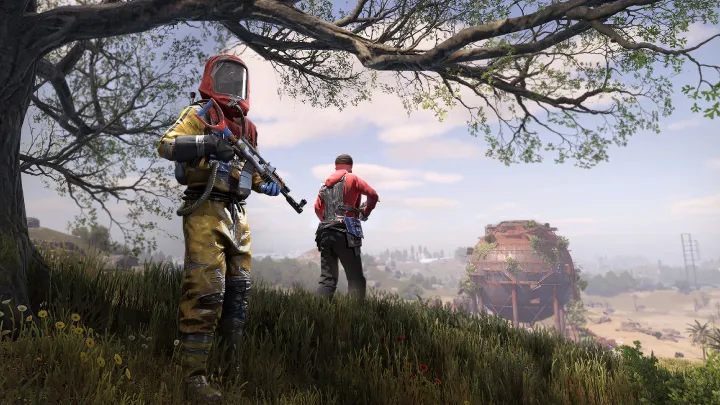Rust is one of the toughest and most intense survival games ever created. With its harsh world, unpredictable players, and constant threats from hunger, wildlife, and radiation, Rust demands strategy, awareness, and determination. Many beginners struggle to understand where to start, how to build, how to fight, and how to survive even a single day. This detailed guide teaches you how to play Rust step by step, arranged in ten meaningful stages following the flow of a fresh wipe to late game domination. Each section includes practical tips, strategies, and important mechanics to help you survive longer and thrive in the chaos.
How to Begin Your First Minutes

Your first minutes in Rust are the most important. You spawn on the beach with only a rock and a torch. The priority is gathering basic materials such as wood and stone. Use your rock to hit trees and stone nodes. This gives you the essential resources needed to craft your first tools.
After gathering a small amount of wood and stone, craft a stone hatchet and stone pickaxe. These early tools drastically increase gathering speed. This is also the time to scout your surroundings. Identify nearby monuments, rivers, forests, and player bases. Knowledge of the terrain helps you choose the safest place to begin building your first shelter.
How to Build a Safe Starter Base
A starter base, often called a 2x1 or a basic square, is crucial for protecting resources. Choose a location that balances safety and access to materials. Avoid crowded beaches and high traffic monuments. Instead, build near forests, small roads, and rivers.
Start by crafting a building plan and hammer. Build a small foundation and add walls, a roof, and a single door. Upgrade everything to wood immediately, and then upgrade to stone when possible. Place a tool cupboard inside the base. The tool cupboard prevents others from building around your structure. A well placed starter base ensures your resources remain secure when you log off.
How to Progress Through Early Game
Once your base is secure, focus on gathering more essential resources. Prioritize collecting cloth from hemp plants, killing animals for meat, and crafting a bow and arrows. A bow gives you the ability to defend yourself and hunt efficiently.
At this point, roam cautiously. Other players are unpredictable, and early game fights can determine your entire progression. Use stealth, avoid open fields, and stay near trees and rocks for cover. The early game goal is to craft better weapons such as the nail gun or waterpipe shotgun. These provide a strong advantage in close range encounters.
How to Use Monuments and Loot Routes
Monuments are key locations that provide powerful loot. Beginners should learn which monuments match their current gear level. Low tier players can explore locations like the harbor, supermarket, and gas station. These offer crates, food, and basic items without high danger.
As you grow stronger, progress to mid tier monuments such as the dome, satellite dish, and sewer branch. These require radiation protection and offer higher tier loot. Learning safe routes, crate spawn patterns, and scientist locations is essential. To stay safe, observe other players from a distance and avoid traveling with full inventory during peak server hours.
A simple recommended loot route for beginners includes
Supermarket
Roadside barrels and crates
Gas station
Small mining outpost
How to Improve Your Weapons and Combat Skills
Rust combat is intense and unforgiving. Both aim and movement are important. Begin practicing with primitive weapons like bows and nail guns. Learn to strafe, crouch, and time your shots. Rust battles often depend on rhythm and accuracy.
As you progress, craft better weapons such as the revolver, double barrel shotgun, or crossbow. Each weapon has different recoil patterns and optimal ranges. When you eventually reach mid game, craft SMGs or rifles once you secure appropriate components. Do not rush into fights without preparation. Always bring bandages, food, and a plan for retreat. Survival matters more than kills.
How to Upgrade and Expand Your Base
Base expansion protects you from raids and improves quality of life. After stabilizing your starter base, expand it into a 2x2 or 2x3 design. Add honeycomb walls, which act as extra layers to slow raiders. Upgrade weak materials to stone or metal.
Inside the base, organize storage boxes, furnaces, sleeping bags, and workbenches. A tier one workbench unlocks primitive and low tier crafting recipes. Moving to tier two and three workbenches requires planning and resource gathering. Proper base structure ensures both safety and efficiency. Add airlocks and multiple door layers to prevent intruders from rushing inside.
How to Use Electricity, Traps, and Quality of Life Systems

As you reach mid and late game, Rust offers advanced systems like electricity. Learning basic circuits helps automate doors, lights, and turrets. Start with small components such as switches, electrical branches, and small solar panels. Electricity improves security and convenience.
Traps can protect your base from offline raiders or intruders. Shotgun traps, flame turrets, and auto turrets are useful when placed strategically. Use traps around door frames or chokepoints. Another important quality of life system is farming. Growing food and materials such as cloth inside your base ensures long term sustainability.
How to Prepare for Raids
Raiding is the heart of Rusts endgame. To raid effectively, you need explosives such as satchel charges, C4, or rockets. Before attempting a raid, scout your target thoroughly. Look for weak walls, soft spots, and signs of player activity. Listen for furnaces, check building decay, and observe door movement.
Plan your raid at a time when the target player is offline or distracted. Bring extra materials for building raid bases or cover. Always have a teammate watch your surroundings. Raiding is risky and can attract counter raiders. Patience, planning, and communication are essential.
How to Defend Against Raids
Base defense is equally important. A strong base layout, honeycombing, and metal doors slow raiders. Stone and metal structures require more explosives to break. Use traps inside entryways and add external walls for extra protection.
During an online raid, communication and calm decision making are critical. Use high ground, peek angles, and cover to your advantage. Repair damaged structures when safe. Store extra materials in multiple hidden boxes in case part of the base is breached. Defending successfully can turn a losing situation into a victory.
How to Thrive in Late Game and Maintain Dominance
By late game, you have access to advanced weapons, vehicles, electricity, and large bases. The challenge becomes maintaining dominance, defending territory, and supporting your team or clan. Use high tier weapons like AKs, MP5s, and bolt action rifles for long range control.
Keep expanding resource collection by farming sulfur, metal, and scrap. Control key monuments and roads. Trade or interact with other players when necessary, but stay cautious. Rusts world changes constantly, and every wipe resets progress. The mindset of adaptability ensures long term success. Build large compound bases, maintain watchtowers, and prepare for wipe cycles.
Conclusion
Rust is a brutal but rewarding survival experience. From gathering your first resources to dominating late game raids, every stage requires strategy, planning, and awareness. By following the methods in this guide, players can improve their survival chances, strengthen their bases, win more fights, and enjoy the full depth of the Rust experience. Whether playing solo or with a group, Rust challenges you to adapt, grow, and fight for every scrap of progress. With enough patience and skill, anyone can thrive in the unforgiving world of Rust.
Summary
A complete how to guide for surviving Rust covering base building, combat, progression, raiding, defense, and late game dominance.

















